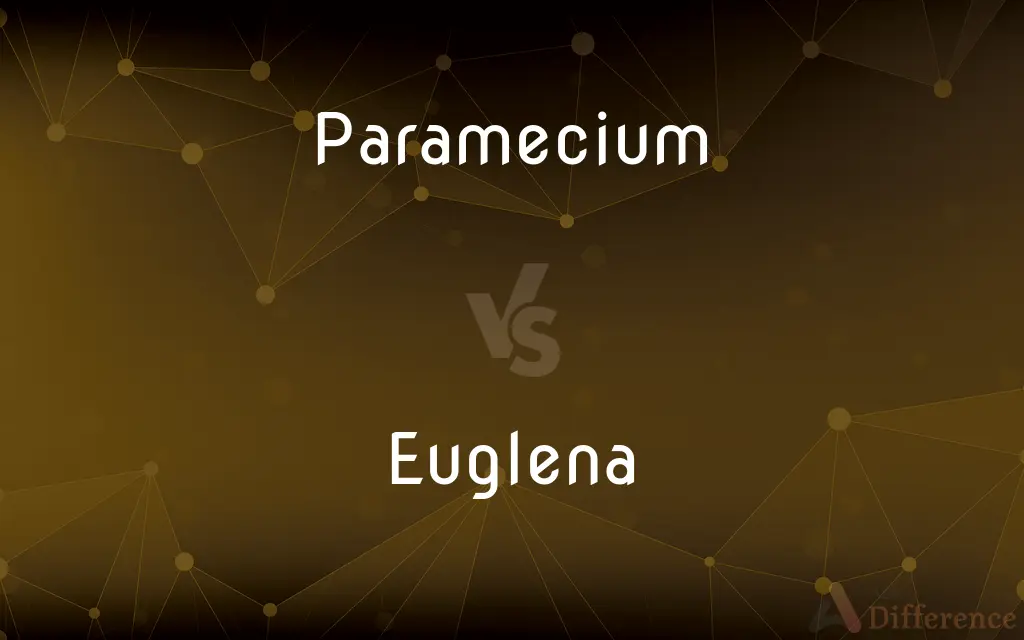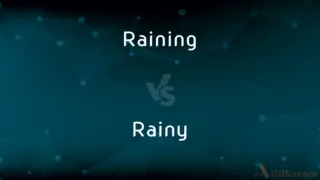Paramecium vs. Euglena — What's the Difference?
By Maham Liaqat & Fiza Rafique — Updated on April 17, 2024
Paramecium moves using cilia and feeds on bacteria, while Euglena uses flagella for movement and can photosynthesize.

Difference Between Paramecium and Euglena
Table of Contents
ADVERTISEMENT
Key Differences
Paramecium is characterized by its use of tiny hair-like structures called cilia for movement and feeding. These cilia cover the cell's surface and help in both locomotion and directing food into the cell's mouth. Whereas, Euglena primarily relies on a whip-like structure known as a flagellum for movement. This single flagellum pulls the cell through water, a significantly different method from the ciliary motion of Paramecium.
In terms of nutrition, Paramecium is a heterotroph, meaning it must consume organic material to survive, typically feeding on bacteria and other small cells. On the other hand, Euglena is mixotrophic, possessing the unique ability to photosynthesize like a plant while also being able to ingest food, making it adaptable to varying light conditions.
Paramecium's shape is more uniform and slipper-like, contributing to its common name "slipper animalcule." Its body is rigid, helping maintain its shape. Conversely, Euglena has a flexible pellicle instead of a rigid cell wall, allowing it to change shape as it moves, which is described as a snake-like motion.
Reproduction in Paramecium typically occurs by binary fission, where the organism splits into two genetically identical organisms. Euglena also reproduces through binary fission but has the ability to survive harsh conditions by forming protective cysts, which Paramecium does not.
Paramecium resides primarily in freshwater environments and is considered an important part of the microbial ecosystem, playing a role in the food web. Euglena, also mainly found in freshwater, can survive in more varied environments due to its photosynthetic capabilities, allowing it to thrive in both light-rich and poor conditions.
ADVERTISEMENT
Comparison Chart
Movement
Uses cilia.
Uses a flagellum.
Nutrition
Heterotrophic, feeds on bacteria.
Mixotrophic, can photosynthesize and eat.
Body Structure
Rigid, slipper-shaped.
Flexible, changes shape while moving.
Reproduction
Binary fission.
Binary fission, can form protective cysts.
Environmental Adaptability
Primarily freshwater environments.
Freshwater, adaptable to various light conditions.
Compare with Definitions
Paramecium
Slipper-shaped and covered with cilia.
The shape of Paramecium helps it move efficiently in water.
Euglena
A genus of unicellular flagellate protozoa.
Euglena uses its flagellum to move through water.
Paramecium
A genus of unicellular ciliated protozoa.
Paramecium move through water by beating their cilia.
Euglena
Can survive harsh conditions by forming cysts.
Euglena forms cysts to endure unfavorable environmental conditions.
Paramecium
Consumes organic materials to survive.
Paramecium feeds on small bacteria and yeast.
Euglena
Adaptable to a variety of aquatic habitats.
Euglena can be found in both clear and murky freshwater environments.
Paramecium
Lives in stagnant or slow-moving freshwater.
Paramecium is commonly found in pond water.
Euglena
Has a flexible body structure allowing movement changes.
The flexibility of Euglena helps it navigate through various water currents.
Paramecium
Paramecium (also Paramoecium, , PARR-ə-MEE-sh(ee-)əm, , -see-əm) is a genus of eukaryotic, unicellular ciliates, commonly studied as a representative of the ciliate group. Paramecia are widespread in freshwater, brackish, and marine environments and are often very abundant in stagnant basins and ponds.
Euglena
Capable of photosynthesis and heterotrophic feeding.
Euglena absorbs sunlight using its chloroplasts to make food.
Paramecium
Any of various slipper-shaped freshwater ciliate protozoans of the genus Paramecium, having an oral groove for feeding.
Euglena
Euglena is a genus of single cell flagellate eukaryotes. It is the best known and most widely studied member of the class Euglenoidea, a diverse group containing some 54 genera and at least 800 species.
Paramecium
An oval-shaped protozoan organism of the genus Paramecium.
Euglena
Any of various single-celled freshwater organisms of the genus Euglena, characterized by the presence of chlorophyll, a reddish eyespot, a single long anterior flagellum, and a second, rudimentary flagellum.
Paramecium
Any member of the genus Paramecium
Euglena
(biology) Any of several protists, of the genus Euglena, that contain chloroplasts and a single flagellum.
Euglena
Minute single-celled green freshwater organism having a single flagella; often classed as algae
Common Curiosities
What environmental conditions favor Paramecium?
Paramecium thrives in stagnant or slow-moving freshwater environments where there is ample organic material to feed on.
What is the significance of flexibility in Euglena’s structure?
The flexibility allows Euglena to change its shape and size, aiding in movement and escape from predators.
Can Euglena perform photosynthesis like plants?
Yes, Euglena has chloroplasts allowing it to perform photosynthesis, unlike Paramecium, which cannot.
How does Euglena adapt to low light conditions?
Euglena can switch to heterotrophic feeding, consuming organic material when light is insufficient for photosynthesis.
Does Euglena require sunlight to survive?
While Euglena can survive on sunlight by photosynthesizing, it is also capable of ingesting organic material, allowing it to survive in environments with low light.
How do Paramecium and Euglena differ in their movement?
Paramecium uses cilia for movement, creating a coordinated wave-like motion, while Euglena uses a flagellum that acts like a whip to pull itself through water.
How do these organisms contribute to their ecosystems?
Both play crucial roles in aquatic food webs, with Paramecium as a consumer of bacteria, and Euglena contributing both as a primary producer and consumer.
Which organism is more adaptable to environmental changes?
Euglena is more adaptable due to its mixotrophic nutrition and ability to form cysts, allowing survival in varied conditions.
Can Paramecium photosynthesize?
No, Paramecium lacks chloroplasts and cannot photosynthesize; it must ingest food to survive.
What unique feature does Euglena have that Paramecium does not?
Euglena has a red eyespot (stigma) that helps it find light sources to optimize photosynthesis, a feature not present in Paramecium.
What kind of diet does Paramecium follow?
Paramecium is exclusively heterotrophic, relying on ingesting bacteria and other small organisms for nutrition.
Are Paramecium and Euglena found in similar habitats?
Both are primarily found in freshwater environments, but Euglena's ability to photosynthesize allows it to inhabit a wider range of light conditions compared to Paramecium.
Share Your Discovery

Previous Comparison
Raining vs. Rainy
Next Comparison
Victory vs. VictorAuthor Spotlight
Written by
Maham LiaqatCo-written by
Fiza RafiqueFiza Rafique is a skilled content writer at AskDifference.com, where she meticulously refines and enhances written pieces. Drawing from her vast editorial expertise, Fiza ensures clarity, accuracy, and precision in every article. Passionate about language, she continually seeks to elevate the quality of content for readers worldwide.
















































